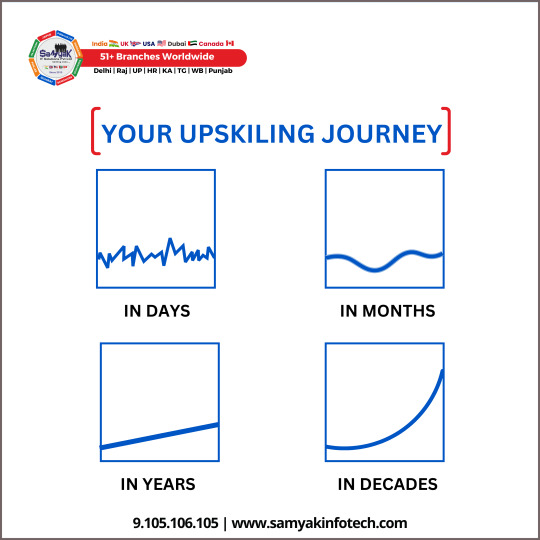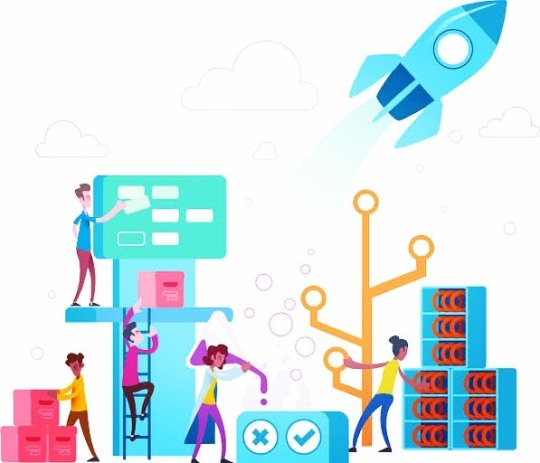#continuousdevelopment
Explore tagged Tumblr posts
Text

#Guess
Let's play 'Guess The Logo!' 🤔
Can you name it?
Drop your guesses below!👇
💻 Explore insights on the latest in #technology on our Blog Page 👉 https://simplelogic-it.com/blogs/
🚀 Ready for your next career move? Check out our #careers page for exciting opportunities 👉 https://simplelogic-it.com/careers/
#LogoChallenge#TechTrivia#Jenkins#CICD#ContinuousIntegration#ContinuousDevelopment#ContnuousDeployment#SoftwareDelivery#Software#GuessTheLogo#Logo#GuessGame#TechLogo#MakeITSimple#SimpleLogicIT#SimpleLogic#MakingITSimple#ITServices#ITConsulting
0 notes
Text

🚀 Build Your Career with DevOps Master Certification Training 🚀
Upgrade your skills and advance your career with the DevOps Master Certification Training offered by Upgrade My Skill, the global leader in professional training. This advanced 3-day course empowers you with in-depth knowledge of DevOps principles, modern tools like Git, Docker, and Jenkins, and practical expertise to excel in IT application management.
🌟 Whether you're an application developer, Agile Scrum Master, or IT service manager, this globally acclaimed training bridges the gap between software development and operations. Learn continuous development, deployment, automation, and collaboration strategies that enhance IT agility and service lifecycles.
📍 Available in multiple U.S. cities and online, our expert trainers bring real-world case studies and best practices to you. Don’t miss this chance to boost your career in the fast-growing world of DevOps!
👉 Enroll Now: https://www.upgrademyskill.com/us/devops-master-certification-training
#DevOpsTraining#DevOpsMasterCertification#UpgradeMySkill#ProfessionalDevelopment#ITCertification#AgileScrum#ApplicationManagement#ContinuousDevelopment#ContinuousDeployment#Automation#ConfigurationManagement#SoftwareDevelopment#DevOpsTools#Git#Docker#Jenkins#Puppet#Nagios#TeamCollaboration#ITServiceAgility#AgileMethodology#ScrumMaster#CareerGrowth#TechTraining#ITCareer#CloudComputing#ProjectManagement#SkillUpgrade#TechSkills#USATraining
0 notes
Text

"Discover the beauty of scaling new heights and redefining yourself by learning something new. Learning something new is like sitting and watching doors unlock one after another while always concentrating and working on oneself.
UpskillingJourney #GrowthThroughLearning #ContinuousDevelopment #EmpowerYourFuture #SkillUp #UnlockYourPotential #LearnAndGrow #ProfessionalGrowth #PersonalDevelopment #EmbraceTheChallenge
samyak #samyakcomputerclasses
0 notes
Text
#CareerStart#PositiveAspects#NegativeAspects#Goals#Values#Mentorship#Networking#LifelongLearning#JobHopping#SkillsGap#CulturalFit#RealisticExpectations#Ambition#Stability#Patience#ContinuousDevelopment
0 notes
Photo

Have you ever designed your build and release pipelines⚡️in AzDevOps and release your app into the clouds☁️? Here's my secret sauce to do that easily and effortlessly while enjoying the ride💥 1. Create an ARM template in your solution for all the configurations for your resource group in Azure💭 2. Once ARM template is done, deploy your ARM trmplate to create resource groups in Azure💗 3. Create a build pipeline with yaml and create artifacts to be used in the release pipeline afterwards👊 4. Create release pipeline using the artifact in build pipeline and make sure that you save your passwords in AzDevOps in variables not in the solution💥 5. You are ready to release your app in Azure☁️ each time you commit a code. Add a trigger in release pipeline so that it will automatically makw the release whenever there is a new successful build is available📣 Let's do this✅ #heartcentrictech #heartcentrictechmentoring #buildpipelines #releasepipeline #azdevops #azure #azurecloud #azurecloudcomputing #cloudcomputing #cloudcomputingservices #continuousintegration #continuousdeployment #continuousdevelopment #continuousdelivery #continuousdeliverypipeline #azuredevopsprojects #azuredevelopment #azuredev #microsoftazure #microsoftazurecloud #microsoftazurefundamentals (at Stockholm, Sweden) https://www.instagram.com/p/COzxxABDMmU/?igshid=axt6uaorbsn4
#heartcentrictech#heartcentrictechmentoring#buildpipelines#releasepipeline#azdevops#azure#azurecloud#azurecloudcomputing#cloudcomputing#cloudcomputingservices#continuousintegration#continuousdeployment#continuousdevelopment#continuousdelivery#continuousdeliverypipeline#azuredevopsprojects#azuredevelopment#azuredev#microsoftazure#microsoftazurecloud#microsoftazurefundamentals
0 notes
Text
DevOps Methodology, Lifecycle and Best Practices explained

DevOps is a software development methodology that combines software development (Dev) with information technology operations (Ops), blending these two worlds in the entire service lifecycle: from the initial product design, through the whole development process, and to production support. In this post, after a brief introduction explaining what the whole DevOps concept is about, we'll try to shed some light over the overall methodology, the consecutive stages defining its lifecycle, and the various best practices that this brand-new concept can bring to the existing companies and software development teams.
What DevOps actually is
Although there is not a uniquely accepted definition for the term "DevOps", there's a general consensus on depicting it as "a set of practices intended to reduce the time between committing a change to a system and the change being placed into normal production, while ensuring high quality". This definition, firstly given by Len Bass, Ingo Weber, and Liming Zhu, correctly frames the theoretical and academic aspects. However, in a more widespread context, the term is frequently used to define a brand-new paradigm to be used in the whole development cycle of an IT product, from the idea to the post-release phases.
Main goal(s)
The whole purpose of adopting a DevOps approach revolves around the following objectives: Faster and Continuous Development Faster and Reliable Quality Assurance Faster and Secure Deployment Faster and Predictable Time to Market Faster and Frequent Releases Most of these goals are achieved through the use of iterative patterns and continuous feedback between end-users, customers, product owners, development, quality assurance, and production engineers. As we can see, the "faster" achievements are easily the primary drivers here: however, for the most part the speed increase is obtained as the result of the best practices adopted to ensure the subsequent goal. To put it in other words, we could say that the speed factor is often the most measurable benefit that comes from switching to a DevOps way of (re)thinking the development process, following the golden principle that working better will also allow us to do our job faster in the long term.
DevOps Toolchains
As DevOps is intended to be a cross-functional mode of working, meaning that it assumes the use of multiple sets of tools rather than a single one. Each of these sets, often called toolchains, is expected to fit into one or more categories. Each category reflects one of the various key aspects (or "phases") of the design, development and/or delivery processes. Here's a list of the most important toolchains, grouped into their respective subsequent categories: Planning: task management, schedules. Coding: code development and review, source code management tools, code merging. Building: continuous integration tools, version control tools, build status. Testing: continuous testing tools that provide quick and timely feedback on business risks, performance measurement. Packaging: artifact repository, application pre-deployment staging. Releasing: change management, release approvals, release automation. Operating: infrastructure installation, configuration and management, infrastructure changes (scalability), infrastructure as code tools, capacity planning, capacity & resource management, security check, service deployment, high availability (HA), data recovery, log/backup management, database management. Monitoring: service performance monitoring, log monitoring, applications performance monitoring, end-user experience, incident management. It goes without saying that each toolchain consists of a set of valuable tools: for example, continuous integration could be addressed with the joint use of Jenkins, Gitlab and Bitbucket pipelines; infrastructure as code can be dealt with using Terraform, Ansible, and Puppet; and so on.
The DevOps Lifecycle
If we take the categories in which we splitted the toolchains into and line them together, we can determine the DevOps product lifecycle: Planning > Coding > Building > Testing > Packaging > Releasing > Operating > Monitoring Some diagrams use Configuring instead of Operating, others talks about Release and Deploy instead of Packaging and Releasing, others encompasses the Testing and Packaging phases into the Continuous Integration container concept (see below), and so on: however, let alone some minimal semantic differences, the overall story is all there.

One of the best DevOps lifecycle + toolchains chart, courtesy of quintagroup.com As we can see, the DevOps phases are more accurate and specific of the typical product phases identified by most product development frameworks (such as Scrum, Kanban and so on): the development phase has been split between coding and building to emphasize the major differences between writing the code and consolidate it; the deployment phase is divided into packaging, releasing and configuring, enforcing the adoption of modern concepts such as reusable resources, shared inventories, risk prevention strategies and DRY approaches. The testing and monitoring phases are also playing a major role there, as we'll be able to see in a short while. If we would try to merge the various DevOps phases within a smaller set of "typical" tasks, we could shrink the lifecycle in the following way: Design > Development > Testing > Deployment > Monitoring Which is nothing but a more concise and general way of saying the same things.
Best Practices
Let's now try to share some light upon the best practices that distinguish the DevOps methodology. Continuous Development The DevOps lifecycle considers the development phase a continuous streams of consecutive iterations with no halt: the entire development process is divided into smaller development sprints with frequent, rapid release cycles. The frequent iterations have the purpose of minimizing any opportunity for bottlenecks to form in the delivery pipeline: whenever a change is ready to move through the pipeline and the pipeline can receive it, it should be deployed as soon as possible. Behaviour-Driven Development Behavior-driven development (BDD), to not be confusing with Test-driven development (TDD) which is an entirely different thing, is an approach where you specify and design an application by describing its behavior from the outside. This involves having high level discussions using specific, realistic examples. Stakeholders tell you how they expect the system to behave, so that you would be able to turn those expectations into acceptance criteria to drive out what you need to develop. Continuous Integration Continuous Integration is a methodology that involves frequent integration of code into a shared repository: the integration may occur several times a day, verified by automated test cases and a build sequence. For some DevOps enthusiasts this concept encompasses the Testing and Packaging phases, to the point that is often used as a synonym/container for these two: we don't follow such approach, as we rather consider CI a development practice which mostly takes place within the building phase: however, as we said earlier, it's often more a semantic debate rather than a conceptual one. Highly-Efficient Testing It goes without saying that the only thing that can ensure that a change (i.e. a new development block) is ready to move through the pipeline is the testing phase, where a dedicated toolchain of testing tools - such as Selenium, Junit, and so on - should be used to remove the bugs while testing the developed software and to ensure there are no new and/or regression flaws: if you know the test-driven development (TDD) principles, you would be happy to know that such approach can be definitely used in DevOps... as long as you are able to implement it in a way that it won't hinder or consistently slow down your development cycles. Unfortunately, from a DevOps perspective, testing manually means introducing avoidable delays into the pipeline. How can we avoid that? The most efficient solution is to use a toolchain which provides automated testing features, at least to some extents. Luckily enough, there are various tools that do just that: Jarvis, for example, is a JavaScript unit testing platform that can be configured to pull off a build attempt and a battery of automated tests each and every time a developer checks in their code into the version control system. Whenever the build or any tests fail, the whole teams receives a notification, thus becoming aware of the issue almost in real-time. It's worth noting that the automated testing approach can be applied to all code, not just application code: for example, all the infrastructure-related scripts required for installing new devices and/or deployment environments should be also treated as code, checked in, and tested automatically. Automated Deployment Manual deployment is often error-prone and slow: these two qualities are definitely against the whole DevOps approach. To minimize human errors, automated deployment is almost always the way to go. You want to be able to quickly and reliably back the change out if there are problems, so you'll need to have a tested rollback plan for each change, whether that means reversing a change, or toggling a new feature off. Behaviour-Driven Development Another important approach of the DevOps best practices follows a behavior-driven development (BDD) instead, an approach where you specify and design an application by describing its behavior from the outside. Continuous Feedback Most, if not all of the DevOps goals are achieved thanks to a strong communication level which make extensive use of continuous feedback between end-users, customers, product owners, development, quality assurance, and production engineers.
Conclusion
That's it, at least for now: we hope that this post will be useful for those who want to know more about the DevOps methodology and find a way to properly implement it within their company or team. If you want to further increase your knowledge, you can also try out one of the many DevOps Online Training courses available on the web nowadays. Read the full article
#Agile#BDD#ContinuousDevelopment#ContinuousFeedback#ContinuousIntegration#DevOps#Lifecycle#Softwaredevelopment#TDD#Toolchains
0 notes
Photo

Life is not so much about what I do for a living, it’s much more about the way I approach my living/life. Personal and professional alignment are vital to me. They are, to me, #oneandthesame ———— #lifealignment #valuesmatter #whatmatters #multipotentialite #liveandleadwithheart #leadwithyourheart #startwithkindness #startwithunderstanding #learnforlife #continuousdevelopment #continuouslearning #lifeisanadventure #learnfromeverything #learnfromeveryone #selfdevelopment #carveyourownpath #lifewithmeaning #lifewithpurpose #womenentrepreneurs #inspirationeverywhere
#whatmatters#lifealignment#carveyourownpath#leadwithyourheart#continuouslearning#selfdevelopment#learnfromeverything#continuousdevelopment#liveandleadwithheart#lifewithmeaning#learnforlife#startwithunderstanding#startwithkindness#valuesmatter#multipotentialite#lifewithpurpose#learnfromeveryone#womenentrepreneurs#lifeisanadventure#inspirationeverywhere#oneandthesame
0 notes
Text

The more one is curious, inquisitive, and eager to learn and understand, the more one is expected to be humble and open to feedback!
#learning #continuousdevelopment
#maturity #careergoals
#personaldevelopment #selfcare #pruserve
www.pruserve.com
0 notes
Link
The Devops Handbook. Development + Operations. Agility and Continuous Development. BUY ON AMAZON - https://t.co/m2T7cC3YmR ⠀ ⠀⠀#thedevopshandbook #devops #technology #agile #continuousdevelopment pic.twitter.com/Bl9GUSh77y
— onlinebusinesscompany (@obcbusinessco) May 25, 2020
via: https://ift.tt/1GAs5mb
0 notes
Text
what you should not forget to consider while learning online?
Increasingly, people are facing the challenges of job surety and higher placements. CSP training could be better utilized in learning scrum fundamentals and in using these tricks in real life business cases. The course is designed in such a way that the student develops problem solving ability with the help of scrum alliance professionals.
CSP certification in Seattle allows you with the wonderful learning experience. As rightly said learning is an ongoing process and one must not miss a chance of acquiring more knowledge and information whenever the opportunity knocks on his door. The training facilitates improved scrum skills that enable you with excellence and quality in your work.
It is one of the essential courses that project managers should look forward to. It emphasizes the goals of the company and how a scrum developer can keep balance with the team and outer clients. The team success is one of the most targeted milestones in the journey of CSP training.
The virtual classroom that is created to provide complete knowledge of scrum fundamentals is led by experienced and talented scrum alliance. They provide better information to the scrums so that they can easily qualify for the CSP certification.
All people are differently blessed. Everyone has different interests. Depending on this fact, 4 different pathways for grabbing the training is formulated. Every pathway has different skill and knowledge. Depending on his interest the learner can choose the one that matches his skills.
While choosing an online way of learning scrum, keep these points in mind-
The website or the institute you are enrolled for learning should be a registered education provider for the scrum.
The authentic institute will help in meeting the requirements of the CSP certification. It will help you complete the desired number of SEUs that is mandatory for scrum certification.
The reputed institute will certify your practical experience and capability in the scrum.
The teaching at the authentic institute helps in becoming a better scrum practitioner. The certification further validates his authenticity.
Some of the learning institutes provide you with the opportunity of seizing scrum alliance membership. This is one of the good qualities of the website that enhances better learning experience. No wonder, being in the group of experienced scrum alliance will definitely help you in better learning experience. Look out for the institute that provides you with this amazing facility.
It also gives you an opportunity of attending scrum events and workshops so that it helps in overall and continuousdevelopment of the interested aspirant.
Four different kinds of routes are made for grabbing the certification. The interested candidate can choose the one that match with his skill and information. Leave the rest on the training institute. The education provider will help you meet all the necessities starting right from imparting scrum fundamentals to completing SEUs till you get specially designed certified logo fixed on your name.
0 notes
Text

#PollTime Which tool is for CI/CD?
a) Jenkins 🛠️
b) Word 📝
c) Notepad 📄
d) Paint 🎨
#PollTime
Cast your #vote
#continuousIntegration#continuousdelivery#continuousdevelopment#paint#word#notepad#jenkins#simplelogic#makingitsimple#itcompany#dropcomment#manageditservices#itmanagedservices#poll#polls#itservices#itserviceprovider#itservicescompany#itservicemanagement#hybrid#onpremises#managedservices#testyourknowledge
0 notes
Photo

#continuousspiritualintegration #continuousintegration #continuousdevelopment #continuousdelivery #continuosdeployment #continuousdesign #lifeextraordinaire
#continuousspiritualintegration#continuosdeployment#lifeextraordinaire#continuousdevelopment#continuousdelivery#continuousintegration#continuousdesign
0 notes
Photo

📣I’m delighted to announce that I’ll be speaking at The Women in Tech World Series Online Festival on 7th-11th June⚡️ The week-long festival offers an immersive, educational experience for like-minded women to access proven strategies and tools to support them in their mission to achieve their career goals👊 Registration is now open, book your pass today and secure a 15% discount with my discount code🙌 I’m super excited to share that Michelle Obama, former First Lady of the United States🇺🇸 will be joining the speaker-line up at this year’s #WiTOnlineFestival👩💻 Looking forward to connecting with you all this June! #heartcentrictech #heartcentrictechmentoring #womenintechnology #womenintech #softwaredevelopment #pathstosoftwarearchitecturemastery #speaker #femalespeakers #softwarearchitecture #softwarearchitect #softwareengineer #femaledeveloper #witonlinefestival #savethedate #7-11june2021 #tech #technology #softwareengineering #softwaredevelopment #microservices #microservicesarchitecture #continuousintegration #continuousdelivery #continuousdevelopment #continuousdeployment (at Stockholm, Sweden) https://www.instagram.com/p/CO43wMLjqqJ/?igshid=1y0x0x399c196
#witonlinefestival👩💻#heartcentrictech#heartcentrictechmentoring#womenintechnology#womenintech#softwaredevelopment#pathstosoftwarearchitecturemastery#speaker#femalespeakers#softwarearchitecture#softwarearchitect#softwareengineer#femaledeveloper#witonlinefestival#savethedate#7#tech#technology#softwareengineering#microservices#microservicesarchitecture#continuousintegration#continuousdelivery#continuousdevelopment#continuousdeployment
0 notes